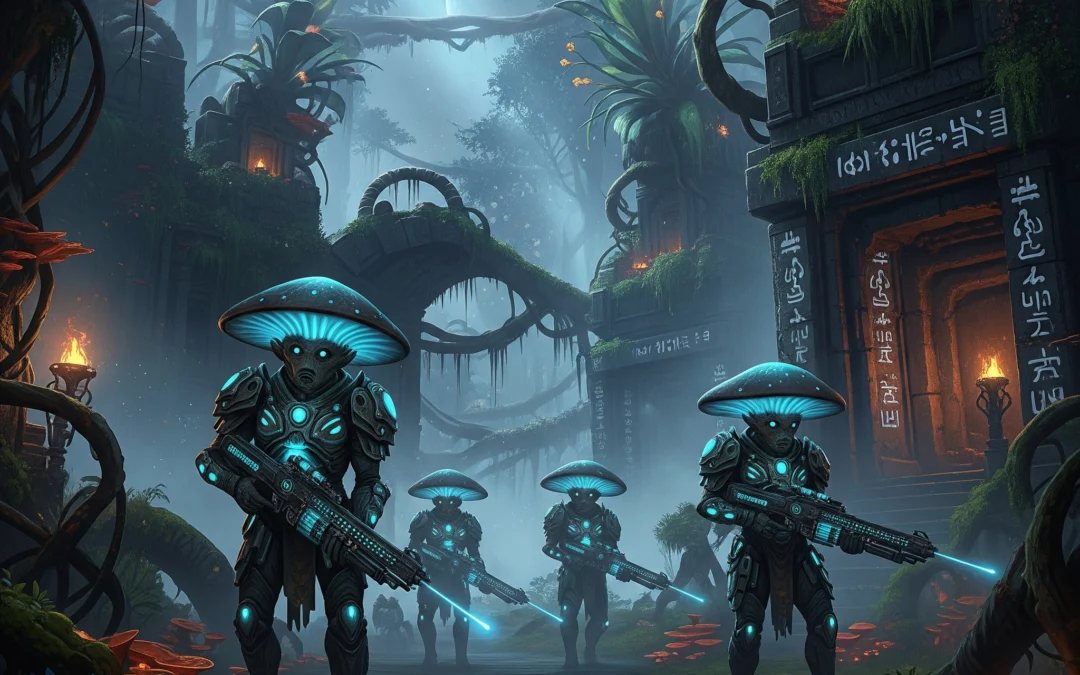The Unfolding Story of Psilocybe cubensis: A Cultural History
Psilocybe cubensis (aka Magic Mushrooms) is arguably the most well-known psychedelic mushroom species. Its incredible story is a long and winding journey that moves from deep history to modern society, weaving together threads of ancient rituals, countercultural rebellion, and a new era of scientific exploration. This mushroom has gone from being a sacred sacrament of indigenous cultures to an icon of the 1960s psychedelic movement, and today, it is at the forefront of a global conversation about mental health and personal well-being. Its journey reflects humanity’s evolving relationship with altered states of consciousness, from spiritual communion to a tool for therapy and self-discovery.
Ancient & Indigenous Use
The story of Psilocybe cubensis begins in the deep past, rooted in the spiritual and cultural lives of indigenous peoples in Mesoamerica. Archaeological evidence and historical records suggest the use of these “sacred mushrooms” dates back at least 2,000 to 3,000 years. For the Aztecs and other Nahua-speaking groups, the mushroom was a central part of their cosmology, often referred to as teonanácatl, or “flesh of the gods.” These ceremonies were not for recreation; they were solemn rituals for divination, healing, and communing with deities like Xochipilli, the “Prince of Flowers,” associated with ecstatic states and spiritual insight.
Spanish conquistadors and missionaries, arriving in the 16th century, viewed these practices as idolatrous and a direct threat to Catholic conversion. They initiated a violent and systematic campaign to suppress the use of teonanácatl, destroying mushroom stones, codices, and other religious artifacts. Despite this immense pressure, these rituals survived, often practiced in secret in remote, isolated communities. The Mazatec people of Oaxaca, Mexico, in particular, maintained a continuous tradition of ritual mushroom use, which would later be “rediscovered” by Westerners, bridging the gap between ancient practices and modern interest.
20th Century to Modern Popularization
While psilocybin mushrooms were known to a handful of ethnobotanists in the early 20th century, their popularization in the Western world began in earnest with the work of R. Gordon Wasson and the Mazatec curandera, María Sabina. Wasson’s 1957 photo-essay in Life magazine, “Seeking the Magic Mushroom,” brought the hidden world of Mazatec rituals to a mass audience. This moment ignited an explosion of interest among counterculture figures, including Timothy Leary, who would go on to champion psychedelics as a tool for expanded consciousness.
In the 1970s, the species’ journey took a significant turn toward domestic availability. The publication of Psilocybin: Magic Mushroom Grower’s Guide by the enigmatic “O. T. Oss” (later revealed to be Terence and Dennis McKenna) was a landmark event. This book is remembered not just as a how-to text but as a cultural catalyst, shifting P. cubensis from a little-known species to one at the center of the psychedelic counterculture. Its impact lay in democratizing access to knowledge about the mushroom and further cementing its symbolic place in psychedelic history.
Therapeutic Research and Legal Shifts
The counterculture association and subsequent government crackdown led to a decades-long period of research stagnation, with psilocybin being classified as a Schedule I substance in the United States, indicating a high potential for abuse and no medical use. However, a significant resurgence of scientific inquiry began in the late 20th and early 21st centuries. Pioneers at institutions like Johns Hopkins University and Imperial College London initiated a new wave of rigorous, placebo-controlled clinical trials.
This research has revealed psilocybin’s remarkable potential as a therapeutic agent. Studies have shown its efficacy in treating conditions such as treatment-resistant depression, end-of-life anxiety in cancer patients, and substance use disorders. While clinical trials often use synthesized psilocybin to ensure precise dosing, the findings directly inform the therapeutic use of the natural mushroom. This scientific validation has, in turn, spurred a broader re-evaluation of drug policy. We have seen a wave of decriminalization initiatives across the United States, with states like Oregon establishing a framework for licensed, psilocybin-assisted therapy, paving the way for a new, regulated paradigm of use.
Place in Modern Society
Today, Psilocybe cubensis occupies a complex and often contradictory position in society. It remains a fixture in underground psychedelic culture, used for everything from spiritual journeys to microdosing for creativity and well-being. At the same time, it is at the heart of a “psychedelic renaissance” that is moving into mainstream medicine and wellness.
This dual identity presents significant challenges. The legal gray areas and lack of regulation mean that safety concerns persist, from misidentifying poisonous lookalikes in the wild to inconsistent potencies between different strains. Issues of cultural appropriation are also at the forefront of the conversation, as a commodified, Western-centric industry emerges from traditions that were once suppressed. As the legal landscape continues to evolve, the future of Psilocybe cubensis will be defined by an ongoing debate about how to balance safe access, ethical practice, and the preservation of its deep historical and cultural roots.
Common Strains: Golden Teacher, B+, & Penis Envy
Golden Teacher
History & Cultural Context: Emerging in the 1980s, Golden Teacher became one of the most recognizable names in psychedelic discussions. Its reputation spread through underground circles and, later, early online forums.
Naming: The name references its distinctive golden hue and the widespread association with themes of introspection or insight.
Impact on Psychedelic Culture: Golden Teacher is often cited as a familiar cultural reference point within the broader psychedelic conversation, symbolizing the continuity of mushroom lore across generations.
B+
History & Cultural Context: First gaining traction in the 1990s, B+ became one of the most frequently mentioned varieties in online mycology communities and underground networks. Its story is often tied to Florida, though exact origins remain debated.
Naming: The meaning behind the name has long been debated, with interpretations ranging from “be positive” to an intentional mystery.
Impact on Psychedelic Culture: B+ is remembered for its visibility in the early internet era, when forums and online communities amplified its reputation. It is commonly referenced in cultural dialogues about psilocybin mushrooms of the late 20th century.
Penis Envy
History & Cultural Context: Believed to have emerged from Amazonian selections in the 1970s, Penis Envy achieved near-mythic status in underground circles due to its rarity and unusual appearance.
Naming: The name derives from its distinct physical characteristics — thick stems and underdeveloped caps — which drew an unmistakable comparison.
Impact on Psychedelic Culture: Penis Envy remains one of the most widely discussed names in mushroom folklore, often appearing in stories, writings, and cultural commentary about the intensity and mystique of certain varieties.
Warnings & Disclaimers
A Note on Our Products: We want to be clear that our products are intended for the cultivation of legal mushroom species only. Any information on this blog is purely for educational and historical context.
Legal Status: Please be aware that the legal status of psilocybin-containing mushrooms varies widely. In the United States, they are classified as a Schedule I substance by federal law, and their possession, sale, and cultivation are illegal in most states. This article is for informational and educational purposes only and does not promote or condone any illegal activities. It is your responsibility to understand and comply with all applicable local, state, and federal laws.
Safety: If you encounter mushrooms in the wild, never consume them unless you are an expert and 100% certain of your identification. Many poisonous species look similar to psilocybin mushrooms, and misidentification can lead to severe illness or even death. For this reason, we strongly advise against foraging for any mushroom you are not absolutely familiar with.
Not Medical Advice: This blog post is not a substitute for professional medical advice, diagnosis, or treatment. We do not endorse the use of psilocybin for any medical or psychological condition without the guidance of a qualified healthcare professional. Always consult with a doctor or therapist before making decisions about your health.
Final Thoughts & Future Outlook
The story of Psilocybe cubensis is still very much being written. We are standing on the cusp of a new chapter, where decades of stigma and suppression are giving way to a more open, scientific, and culturally nuanced conversation. As ongoing research continues to unveil the therapeutic potential of psilocybin, we can anticipate a significant shift in how these fungi are perceived and utilized. The future may involve a more integrated system where natural products and synthetic compounds coexist, providing a range of options for healing and personal growth. Ultimately, the potential for psilocybin to treat conditions like depression, anxiety, and PTSD promises to reshape our understanding of mental health and usher in a new era of psychedelic medicine.

